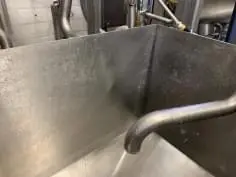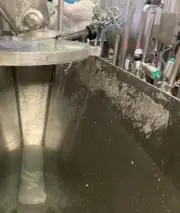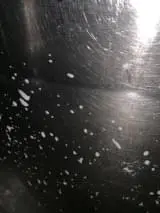HBW SOLVES A TRICKY ENGINEERING PROBLEM IN THE DAIRY.
THE ART OF HYDRAULICS!
It is a special opportunity when you walk into a client’s decades old facility, meet the operations staff, and hear, “Five other companies have tried to fix our problem, what makes you think you have an answer?”. Turns out we did. Let’s talk about cheese fines recovery.
For those of you who don’t know a thing about making cheese, as the curds come off the line and out of the whey, there are left over “fines” that slip through the straining mechanism. This is good cheese that if you can recover it, can be brought back into the processing system for finishing.
This client had a fines recovery system that was having difficulty passing cleaning validation. The system in question consisted of:
- Three Fines Savers
- Two Open Top Fines Collection Troughs
- Three Open Top Whey Tanks
- One Hold Tube
- Approximately 300 feet of Whey Transfer Line
- One Spiral Heat Exchanger with a 1” DIA Coil (Installed in a 2” discharge line)
- Five Pumps
- CIP of 23 Different Process Paths Between 1” and 3” DIA
The first step of any project is to develop the conceptual design to create the overall game plan that will be followed throughout the project.
- We reviewed the installation and developed process flow diagrams that
included any new equipmentrequired.
— Additional Valves
— Custom Lids with Spray Devices for Open Top Tanks (Lids Set Off to Prevent Metal to Metal Contact Internal to the Tank)
— Piping - Verified the CIP program being used. Extending the pre-rinse to remove more soil was a big part of the solution.







Detail design consisted of developing piping isometric drawings, hydraulic calculations, equipment bid packages and automation redesign.
We implemented staged process piping and code modifications over a set of three monthly facility down days (24 hours where the plant isn’t making product).
At the end of the project, an issue that had been lingering for years had been solved and cleaning was able to pass routinely!
Other Notes:
-
1. $200 MILLION EXPANSION OF AN API FACILITY.
EXPANDING ROLES! -
2. $1 BILLION GREENFIELD PLASMA FRACTIONATION FACILITY.
SUPERSTAR START-UP! -
3. TURNING UREA TANKERS INTO CONSTANT STIR TANKS.
WHAT A NOVEL CONCEPT! -
5. INTEGRATING PROCESS AND AUTOMATION DESIGN.
A RETROFIT FOR THE AGES! -
6. SOLVING SYSTEM CONTAMINATIONS.
IT’S THE LITTLE THINGS! -
7. TURNING OUR EYES TOWARD THE ENERGY SECTOR IN
AUTOMATION. READY, SET, LAUNCH! -
8. USING OUR TALENTS TO TEACH THE NEXT GENERATION.
TRAINING TOMORROW!